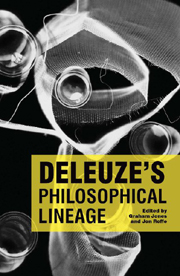Book contents
- Frontmatter
- Contents
- Acknowledgements
- List of Abbreviations
- Introduction: Into the Labyrinth
- 1 Plato
- 2 John Duns Scotus
- 3 G. W. F. Leibniz
- 4 David Hume
- 5 Immanuel Kant
- 6 Solomon Maimon
- 7 G. W. F. Hegel
- 8 Karl Marx
- 9 Hoëne Wronski and Francis Warrain
- 10 Bernhard Riemann
- 11 Gabriel Tarde
- 12 Sigmund Freud
- 13 Henri Bergson
- 14 Edmund Husserl
- 15 A. N. Whitehead
- 16 Raymond Ruyer
- 17 Martin Heidegger
- 18 Pierre Klossowski
- 19 Albert Lautman
- 20 Gilbert Simondon
- Bibliography
- Notes on Contributors
- Index
2 - John Duns Scotus
Published online by Cambridge University Press: 12 September 2012
- Frontmatter
- Contents
- Acknowledgements
- List of Abbreviations
- Introduction: Into the Labyrinth
- 1 Plato
- 2 John Duns Scotus
- 3 G. W. F. Leibniz
- 4 David Hume
- 5 Immanuel Kant
- 6 Solomon Maimon
- 7 G. W. F. Hegel
- 8 Karl Marx
- 9 Hoëne Wronski and Francis Warrain
- 10 Bernhard Riemann
- 11 Gabriel Tarde
- 12 Sigmund Freud
- 13 Henri Bergson
- 14 Edmund Husserl
- 15 A. N. Whitehead
- 16 Raymond Ruyer
- 17 Martin Heidegger
- 18 Pierre Klossowski
- 19 Albert Lautman
- 20 Gilbert Simondon
- Bibliography
- Notes on Contributors
- Index
Summary
Of all Deleuze's concepts, that of univocity or univocal being remains perhaps the most elusive and liable to confuse contemporary interpreters. Given its literal meaning as a single sense or voice, and despite Deleuze's own formulation of the univocity of being as a univocity of difference, it is easily assumed that the term is meant to suggest an ultimate unity that tempers Deleuze's philosophy of multiplicity. Indeed, this view underpins readings that subsume the univocity of being under a Platonist conception of the One and then accuse Deleuze of closet Platonism. If for no other reason than this, it is crucial to understand the Aristotelian origins of the concept of univocity, along with its historical use in medieval thought to resolve lingering problems in Platonist-Augustinian theology. John Duns Scotus, the thirteenthcentury Franciscan scholastic known as the ‘subtle doctor’, is a central figure in this history and, unsurprisingly, the first of the three principal figures Deleuze identifies as forming the philosophical lineage of the concept (DR 39). Deleuze names Spinoza and Nietzsche as the successors to Duns Scotus, although neither thinker uses the term univocity.
Fundamentally, univocity concerns relations established within primary diversity, where differences are related and yet common identity and unity are absent. For Deleuze, such relations constitute a multiplicity or assemblage. Deleuze's most sustained development of univocity, and the place where he engages most extensively with Duns Scotus, is found in the chapter on ‘difference in itself’ in Difference and Repetition.
- Type
- Chapter
- Information
- Deleuze's Philosophical Lineage , pp. 27 - 43Publisher: Edinburgh University PressPrint publication year: 2009



